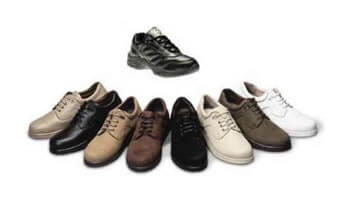 Choosing the right shoe for your foot is very important for maintaining good foot health, while helping to prevent injuries and many common podiatric conditions such as plantar fasciitis, neuropathy, corns, calluses, bunions, hammertoes, Achilles tendon pain, ingrown toenails, and more.
Choosing the right shoe for your foot is very important for maintaining good foot health, while helping to prevent injuries and many common podiatric conditions such as plantar fasciitis, neuropathy, corns, calluses, bunions, hammertoes, Achilles tendon pain, ingrown toenails, and more.
There are seven basic tips on selecting the best possible shoes to keep your feet healthy:
- Get the size right. Start by having your feet measured at a shoe store. Know the length and width of your feet. Every time you buy shoes you should have your feet measured, as people’s feet widen and stretch as they age. Shop at the end of the day when your feet are at their widest. Don’t buy shoes that feel tight thinking you’ll wear them in.
- Start with a firm foundation. Your feet support the entire body so test the quality of a shoe’s foundation before purchasing it. It should offer plenty of support. Gently bending the shoe at the toe will clue you in on whether the foundation is too soft (it will fold in half). A good foundation will bend slightly but remain mostly rigid.
- Insist on arch support. Flat-soled soles will cause pain in your feet over time, so choose shoes that have built-in arches.
- Lace it up. Shoes with laces provide better support than slip-ons because they do a better job of holding your foot in place with the sole, and they provide better support.
- Let the toes breathe. It’s important that shoes are not too narrow at the tip (toe box). Wider toe boxes give toes the room they need and will prevent hammertoes, bunions and neuropathy from developing.
- Choose comfort first. Bargain shoes or the latest trends should take a back seat to comfort. Try on different brands and styles to see what is most comfortable. If you must wear high heels, don’t do it every day and choose heels that are wider and lower than stilettos. Make sure the toe box is not too narrow as well.
- Nothing lasts forever: especially shoes. When your shoes start to wear down around the balls of the feet and heels, it’s time to toss them.
Ask your podiatrist for other recommendations on proper shoes and what specific features you might want to look for when purchasing new shoes.
